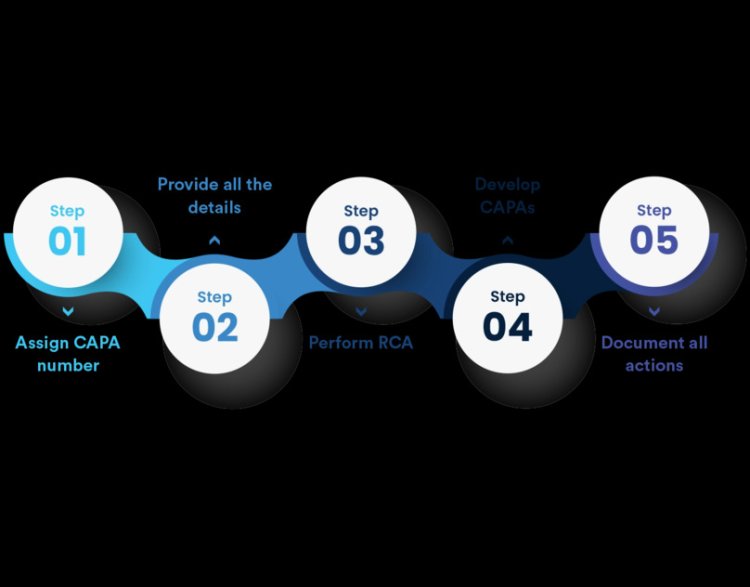How CAPA Can Increase Customer Satisfaction in Your Business
Share this Post to earn Money ( Upto ₹100 per 1000 Views )

In today's competitive business landscape, ensuring customer satisfaction is paramount. Companies that prioritize customer feedback and implement corrective actions can significantly enhance their reputation and retain loyal customers. One powerful tool that organizations can leverage is Corrective and Preventive Action (CAPA).
Understanding CAPA and Its Importance
What is CAPA?
CAPA is a systematic approach used by organizations to identify, rectify, and prevent issues that could potentially lead to non-conformance. CAPA processes are vital in ensuring product quality and regulatory compliance, especially in industries such as medical devices and pharmaceuticals.
The Role of CAPA in Customer Satisfaction
Implementing an effective CAPA system directly correlates with improved customer satisfaction. By addressing issues proactively, organizations can enhance product quality, reduce defects, and ultimately deliver better value to their customers. In a market where customers have numerous choices, this distinction can make a significant difference.
CAPA in Life Sciences and Manufacturing
CAPA ISO 9001: A Framework for Quality Management
For organizations in the Life Sciences and Manufacturing sectors, aligning with CAPA ISO 9001 provides a robust framework for quality management. This standard emphasizes the importance of customer satisfaction and encourages organizations to establish processes that monitor and improve quality.
CAPA ISO 13485: Ensuring Quality in Medical Devices
For businesses in the medical device sector, adherence to CAPA ISO 13485 is crucial. This standard focuses on meeting regulatory requirements and ensuring that quality management systems are in place. By implementing CAPA processes that align with ISO 13485, organizations can enhance product quality and boost customer confidence.
Corrective vs. Preventive Action
Understanding the Difference
While corrective action addresses existing problems, preventive action focuses on identifying potential issues before they occur. Both aspects are integral to a comprehensive CAPA strategy. Understanding the nuances between corrective vs. preventive action can help organizations develop more effective CAPA processes that ultimately lead to higher customer satisfaction.
The Impact of Effective CAPA Processes
An effective CAPA process that incorporates both corrective and preventive actions ensures that organizations can respond to customer complaints swiftly and effectively. This proactive approach not only resolves current issues but also mitigates future risks, fostering a culture of continuous improvement.
Benefits of CAPA in Enhancing Customer Satisfaction
Increased Product Quality
By implementing CAPA, organizations can systematically address and eliminate defects in their products. This increased focus on quality results in fewer complaints and higher customer satisfaction levels.
Improved Customer Feedback Mechanisms
A well-structured CAPA system facilitates better feedback collection from customers. By understanding customer concerns and acting upon them, organizations can continuously improve their products and services.
Greater Transparency and Trust
When companies actively communicate their CAPA efforts, they build trust with their customers. Transparency regarding how issues are handled reassures customers that their concerns are taken seriously, further enhancing satisfaction.
Strengthening Brand Reputation
In industries such as Life Sciences and Manufacturing, a strong brand reputation is vital. By consistently delivering high-quality products through effective CAPA processes, organizations can strengthen their brand and ensure long-term success.
Implementing an Effective CAPA System
Establishing Clear Processes
For CAPA to be effective, organizations must establish clear processes that define how corrective and preventive actions will be identified, documented, and tracked. This includes setting specific responsibilities for teams and ensuring all employees understand their roles.
Training and Development
Investing in training and development ensures that employees are equipped with the knowledge and skills to implement CAPA effectively. Regular training sessions can help reinforce the importance of CAPA in achieving organizational goals.
Utilizing Technology for CAPA Management
Adopting advanced quality management systems can streamline CAPA processes. By utilizing technology to track issues, document actions, and analyze data, organizations can enhance their ability to respond to customer needs quickly.
Challenges in Implementing CAPA
Resistance to Change
Organizations may face resistance when implementing new processes. To overcome this, it is essential to communicate the benefits of CAPA clearly and engage employees at all levels in the process.
Ensuring Compliance with Regulatory Standards
In regulated industries, maintaining compliance with standards such as CAPA ISO 9001 and CAPA ISO 13485 can be challenging. Organizations must stay updated on regulatory changes and ensure their CAPA processes remain aligned with these requirements.
Conclusion
In conclusion, implementing an effective CAPA system can significantly enhance customer satisfaction in your business. By focusing on quality improvement, effective feedback mechanisms, and transparency, organizations can build trust and strengthen their brand reputation. ComplianceQuest Management Software offers a comprehensive solution for businesses looking to enhance their CAPA processes. In 2024, leveraging such technology will be essential for organizations striving to stay ahead in a competitive and highly regulated environment.
By embracing CAPA as a critical component of your quality management strategy, you position your business to better meet customer expectations and drive long-term success.
















